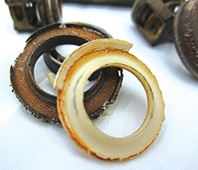
Can you identify and avoid cavitation… the formation and collapse of gaseous cavities in a liquid which causes severe wear or eroding of the metal wear surfaces in the pump.
To the right are packings and check valves from a 3-month old pump that was starved of water and consistently left in by-pass for more that 5 minutes at a time.
The most obvious sign of cavitation is a hammering noise. The noise can be either consistent or intermittent depending upon the degree of cavitation and damage to the pump. Vibration of the pump and system will also be noticeable as the pump is starved of fluid. Eventually flow and pressure will decrease.
Check your system for these conditions which may contribute to, or directly cause, cavitation:
1. Inadequate inlet line size
2. Insufficient inlet flow or excessive suction (the most common problem)
3. Excessive inlet line length
4. Rigid inlet plumbing
5. Too many elbows and/or fittings
6. Excessive temperature build-up or pumped fluid
7. Air leak in inlet plumbing
8. Agitation in supply reservoir
9. Inadequate increase of inlet flow for fluids of greater specific gravity
10. Inadequate increase of inlet flow for higher temperature fluids
11. Clogged inlet filters.
12. Never allow your pump to stay in ‘by-pass’ for more than 4 minutes at a time. When you do the pump will heat up and damage the pump and void all warranties.



